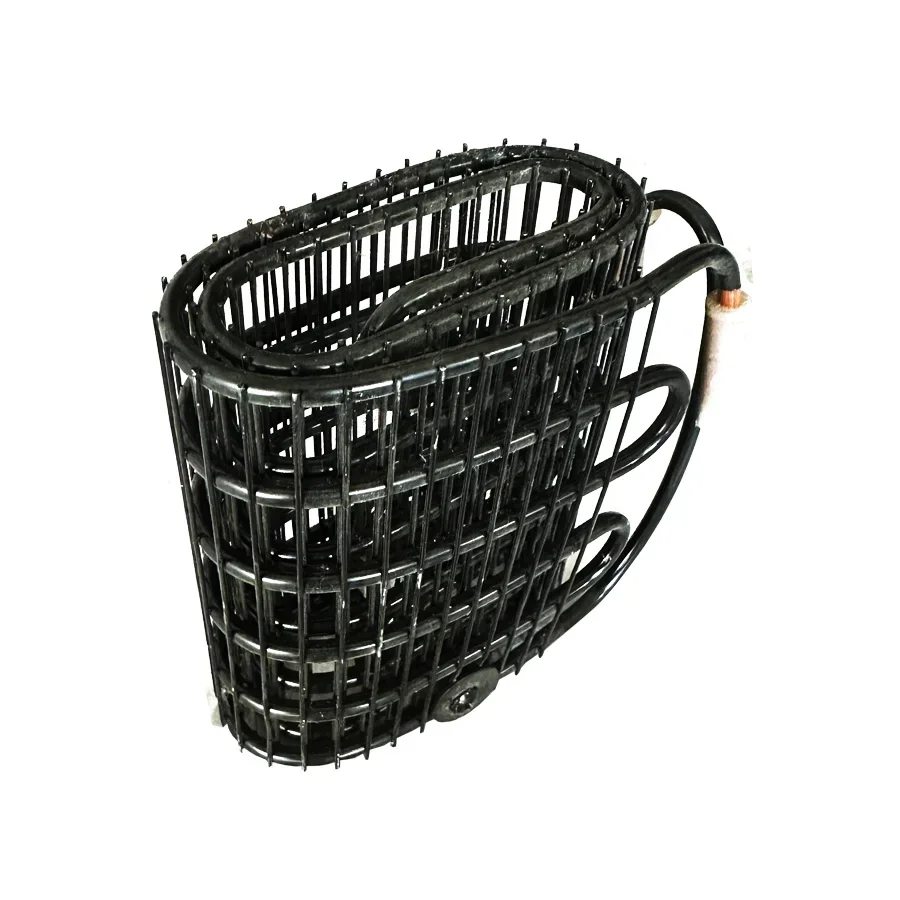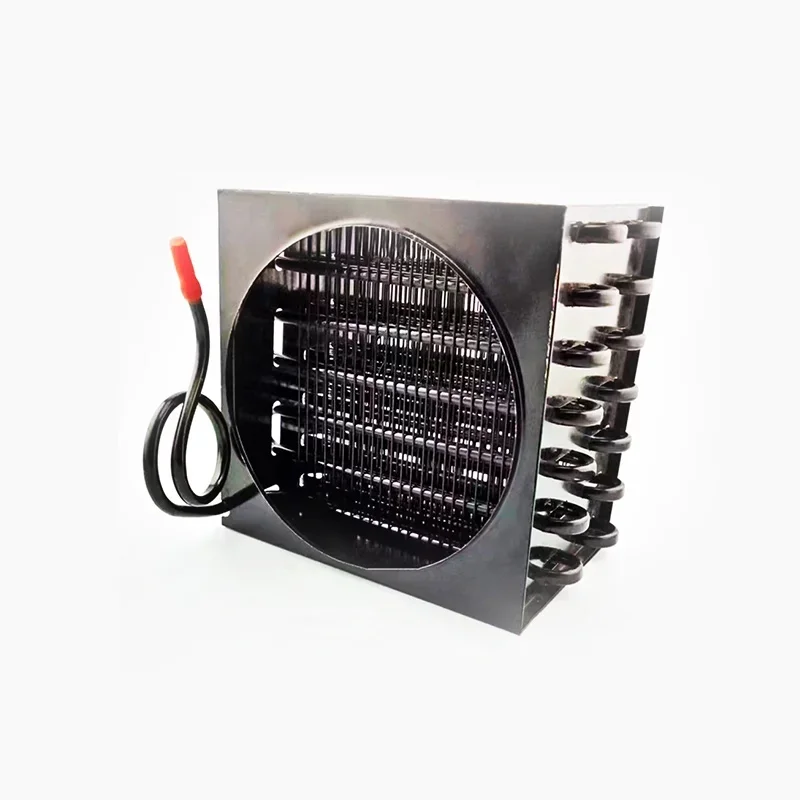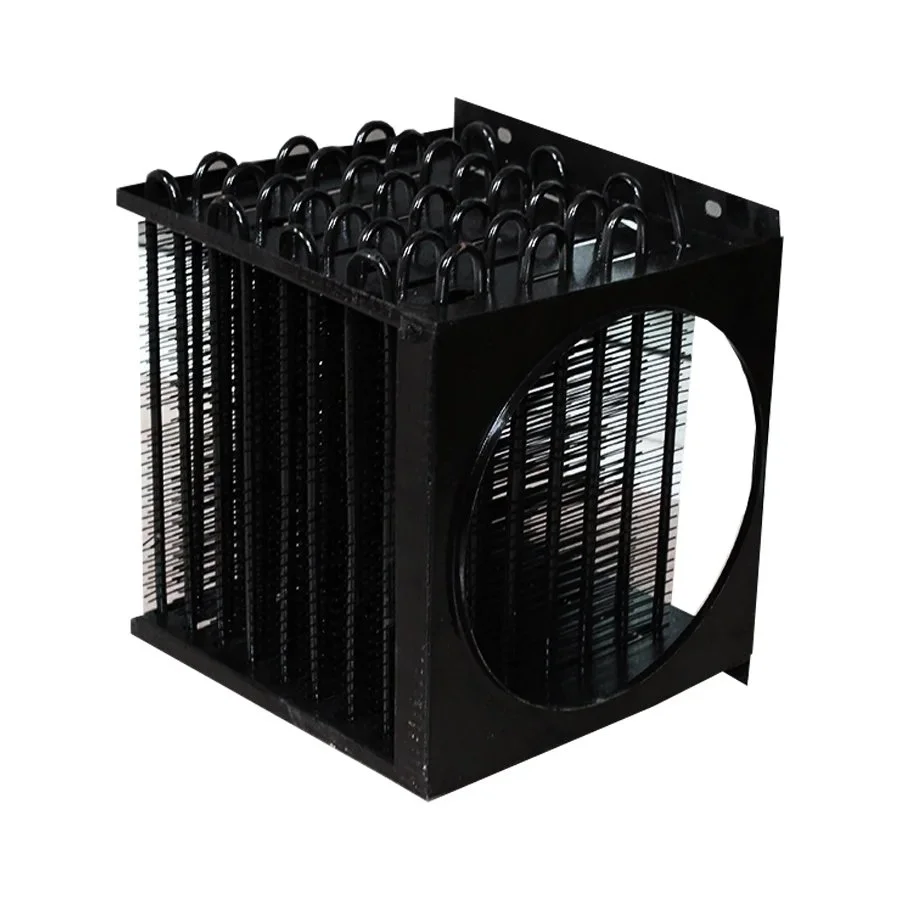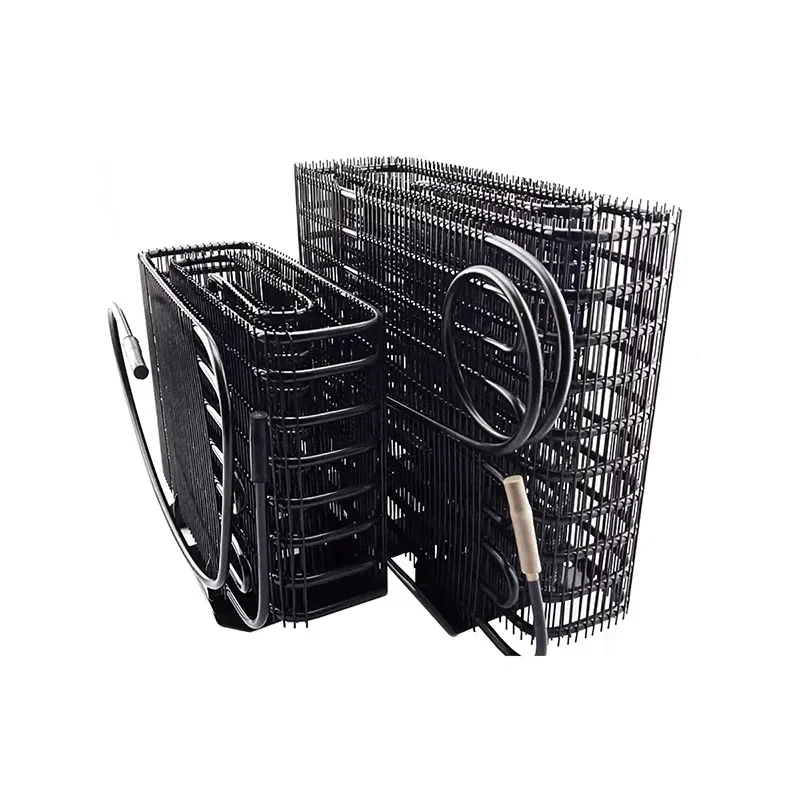SENJUN's blog
Wire-tube condenser is a common heat exchanger, widely used in air conditioning, refrigeration units, cold storage, and other fields. Its development history can be traced back to the late 19th century. After years of development and improvement, it has now become an efficient and reliable heat exchanger. This article will discuss the origin, development, and application of wire-tube condensers.
1. The origin of wire-tube condenserThe earliest origins of wire-tube condensers can be traced back to the late 19th century. At that time, people began to use steam engines and steam engines to drive machines and equipment. These machines and equipment require cooling to keep them functioning properly. At that time, the cooling methods used by people were mainly water cooling and air cooling. However, there are some problems with these methods, such as water cooling requiring a large amount of water resources, while air cooling is inefficient and cannot meet the needs of machines and equipment.
In order to solve these problems, people began to study new cooling methods. In this process, wire-tube condenser came into being. A wire-tube condenser is a heat exchanger that achieves cooling by flowing a cooling medium (such as water or air) over the outer surface of the tube to transfer heat from the inside of the tube to the outside. This cooling method is not only efficient but also resource-saving, so it soon became widely used.

The development of wire-tube condensers has gone through many stages. In the early days, wire-tube condensers were mainly composed of copper tubes and copper sheets. This type of condenser has a simple structure and low manufacturing cost, but its efficiency is low and cannot meet the needs of large machines and equipment.
With the continuous advancement of technology, the structure and materials of wire-tube condensers have also been continuously improved. In the 1950s, people began to use aluminum tubes and sheets to make wire-tube condensers. This type of condenser has the advantages of being lightweight, high heat dissipation efficiency, and corrosion resistance, so it was soon widely used.
With the continuous development of air conditioners, refrigeration units, and other equipment, the requirements for wire-tube condensers are becoming higher and higher. In order to meet these requirements, people began to research new materials and structures. For example, people have begun to use materials such as stainless steel and titanium alloys to manufacture wire-tube condensers. These materials have the advantages of corrosion resistance and high-temperature resistance and can meet higher requirements.
In addition, new structures have also been studied, such as spiral wire-tube condensers, plate condensers, etc. These structures have higher heat dissipation efficiency and smaller size, and can meet more application needs.
3. Application of wire-tube condenserWire-tube condenser is a widely used heat exchanger, mainly used in air conditioning, refrigeration units, cold storage, and other fields. Its main function is to transfer the heat of the refrigerant to the cooling medium to achieve the purpose of refrigeration.
In the field of air conditioning, wire-tube condensers are usually used in outdoor units. It cools indoor air by transferring heat from the refrigerant to the air. In the field of refrigeration units, wire-tube condensers are usually used in condensers. It achieves the purpose of refrigeration by transferring the heat of the refrigerant to water or air. In the field of cold storage, wire-tube condenser is usually used in the refrigeration system of cold storage. It achieves refrigeration in cold storage by transferring the heat of the refrigerant to water or air.
In addition to the above application fields, wire-tube condensers can also be used in other fields, such as chemical industry, medicine, and other fields. It can transfer heat from chemical reactions to control the reaction temperature; it can also transfer heat from medicines to ensure the quality of medicines.
The wire-tube condenser is an important heat exchanger whose development history can be traced back to the end of the 19th century. After years of development and improvement, it has now become an efficient and reliable heat exchanger. With the continuous advancement of technology, the structure and materials of wire-tube condensers have also been continuously improved to meet higher requirements. Wire-tube condenser is widely used in air conditioning, refrigeration units, cold storage, and other fields, and can meet the needs of different fields.
https://www.ningbo-senjun.com/The-development-history-of-wire-tube-condenser.html
In the refrigeration system, the wire-tube condenser plays a vital role, and its refrigeration effect directly affects the performance and energy efficiency of the entire refrigeration system. There are many factors that affect the refrigeration effect of wire-tube condensers, including structural design, material selection, working environment, and other aspects. This article will discuss these factors in order to provide readers with a comprehensive perspective on the refrigeration effect of wire-tube condensers.

The structural design of the wire-tube condenser is one of the important factors affecting its refrigeration effect. First of all, the layout and length of the pipeline will directly affect the heat exchange efficiency of the condenser. A reasonable pipeline layout and sufficient length can increase the heat exchange area of the condenser and improve the cooling effect. Secondly, the diameter and wall thickness of the pipeline will also affect the refrigeration effect. Appropriate diameter and wall thickness can reduce the pressure drop of the refrigeration system and improve the refrigeration efficiency.
2. Material selectionThe material selection of the condenser is directly related to its thermal conductivity and corrosion resistance, thus affecting the cooling effect. Usually, metal materials such as copper and aluminum are common choices. They have good thermal conductivity and corrosion resistance, which are beneficial to improving the cooling effect. In addition, the surface treatment of the material will also have an impact on the refrigeration effect. For example, increasing the surface roughness can increase the heat transfer coefficient, thereby improving the refrigeration effect.
3. Working environmentThe working environment of the refrigeration system is also one of the important factors affecting the refrigeration effect of the wire-tube condenser. Ambient temperature, humidity, air circulation, etc. will all affect the heat dissipation effect of the condenser. In high temperature and high humidity environments, the heat dissipation effect of the condenser will be affected to a certain extent, thereby reducing the cooling effect. Therefore, in practical applications, the condenser needs to be reasonably designed and selected according to the specific working environment to ensure a good cooling effect.
4. Refrigerant selectionThe choice of refrigerant also has an important impact on the cooling effect of the condenser. Different refrigerants have different heat transfer properties and compression properties, which will affect the working status and refrigeration effect of the condenser. Therefore, when designing and selecting a refrigeration system, it is necessary to fully consider the selection of refrigerant to improve the cooling effect of the condenser.
5. System matchingFinally, the cooling effect of the condenser is also affected by the matching of the entire refrigeration system. The matching of the compressor, evaporator, and other components in the refrigeration system with the condenser will directly affect the working status and cooling effect of the condenser. Therefore, when designing and selecting a refrigeration system, it is necessary to fully consider the matching of various components to improve the cooling effect of the condenser.
To sum up, the refrigeration effect of the wire-tube condenser is affected by many factors, including structural design, material selection, working environment, refrigerant selection, and system matching. Only by comprehensively considering these factors and carrying out reasonable design and selection can the cooling effect of the condenser be improved, thereby improving the performance and energy efficiency of the entire refrigeration system.
https://www.ningbo-senjun.com/Key-Factors-Affecting-the-Cooling-Effect-of-Wire-Tube-Condenser.html
In the refrigeration system, the wire-tube condenser plays a vital role, and its refrigeration effect directly affects the performance and energy efficiency of the entire refrigeration system. There are many factors that affect the refrigeration effect of wire-tube condensers, including structural design, material selection, working environment, and other aspects. This article will discuss these factors in order to provide readers with a comprehensive perspective on the refrigeration effect of wire-tube condensers.

The structural design of the wire-tube condenser is one of the important factors affecting its refrigeration effect. First of all, the layout and length of the pipeline will directly affect the heat exchange efficiency of the condenser. A reasonable pipeline layout and sufficient length can increase the heat exchange area of the condenser and improve the cooling effect. Secondly, the diameter and wall thickness of the pipeline will also affect the refrigeration effect. Appropriate diameter and wall thickness can reduce the pressure drop of the refrigeration system and improve the refrigeration efficiency.
2. Material selectionThe material selection of the condenser is directly related to its thermal conductivity and corrosion resistance, thus affecting the cooling effect. Usually, metal materials such as copper and aluminum are common choices. They have good thermal conductivity and corrosion resistance, which are beneficial to improving the cooling effect. In addition, the surface treatment of the material will also have an impact on the refrigeration effect. For example, increasing the surface roughness can increase the heat transfer coefficient, thereby improving the refrigeration effect.
3. Working environmentThe working environment of the refrigeration system is also one of the important factors affecting the refrigeration effect of the wire-tube condenser. Ambient temperature, humidity, air circulation, etc. will all affect the heat dissipation effect of the condenser. In high temperature and high humidity environments, the heat dissipation effect of the condenser will be affected to a certain extent, thereby reducing the cooling effect. Therefore, in practical applications, the condenser needs to be reasonably designed and selected according to the specific working environment to ensure a good cooling effect.
4. Refrigerant selectionThe choice of refrigerant also has an important impact on the cooling effect of the condenser. Different refrigerants have different heat transfer properties and compression properties, which will affect the working status and refrigeration effect of the condenser. Therefore, when designing and selecting a refrigeration system, it is necessary to fully consider the selection of refrigerant to improve the cooling effect of the condenser.
5. System matchingFinally, the cooling effect of the condenser is also affected by the matching of the entire refrigeration system. The matching of the compressor, evaporator, and other components in the refrigeration system with the condenser will directly affect the working status and cooling effect of the condenser. Therefore, when designing and selecting a refrigeration system, it is necessary to fully consider the matching of various components to improve the cooling effect of the condenser.
To sum up, the refrigeration effect of the wire-tube condenser is affected by many factors, including structural design, material selection, working environment, refrigerant selection, and system matching. Only by comprehensively considering these factors and carrying out reasonable design and selection can the cooling effect of the condenser be improved, thereby improving the performance and energy efficiency of the entire refrigeration system.
https://www.ningbo-senjun.com/Key-Factors-Affecting-the-Cooling-Effect-of-Wire-Tube-Condenser.html
As an important heat exchange equipment, a wire-tube condenser plays a key role in many industries. With the continuous advancement of technology and changes in market demand, Wire-tube condenser is facing new development directions and challenges. This article will discuss the future development direction of the wire-tube condenser, analyze the challenges faced, and look forward to its future development prospects.
Part 1: The future development direction of Wire-tube condenser1.1 Green environmental protection and energy efficiency
With the increasing awareness of environmental protection, the future development of Wire-tube condensers will pay more attention to green environmental protection and energy efficiency. By using advanced materials and designs, we optimize heat transfer efficiency and reduce energy consumption and environmental pollution to meet the needs of sustainable development.
1.2 Intelligence and automation
With the continuous development of intelligence and automation technology, Wire-tube condensers will develop in the direction of intelligence and automation. By introducing advanced sensors, control systems, and artificial intelligence technology, automatic monitoring, optimized operation, and fault diagnosis are achieved, and the intelligence level and operating efficiency of the equipment are improved.
1.3 Multifunctional and customized design
In the future, Wire-tube condensers will tend to be multifunctional and customized in design. According to the needs of different industries and application fields, wire-tube condensers are customized to meet specific heat exchange needs and provide more flexible and efficient solutions.

2.1 Improvement of heat transfer efficiency: The heat transfer efficiency of the wire-tube condenser directly affects its performance and energy utilization efficiency. How to improve heat transfer efficiency by improving heat transfer interface and fluid dynamics design is one of the current challenges.
2.2 Research on multi-field coupling issues: Wire-tube condenser involves the coupling of multiple physical fields during operation, such as heat conduction, fluid flow phase change, etc. How to study and solve these multi-field coupling problems is of great significance to improving the performance and reliability of the condenser.
2.3 Multi-scale modeling and optimized design: The structure and working process of the Wire-tube condenser involve multiple scales, from microscopic flow in the tube to macroscopic overall performance. How to conduct multi-scale modeling and optimized design to achieve a more efficient and reliable condenser is one of the current challenges that need to be solved.
2.4 Cost pressure: The cost of a Wire-tube condenser is relatively high, which is a challenge to its development. The future development direction is to reduce the cost of wire-tube condensers and make them more competitive by reducing material costs, improving production efficiency, and large-scale production.
2.5 Market recognition: As an emerging cooling technology, a Wire-tube condenser needs to be recognized and accepted by the market. This requires promotion and publicity, as well as comparison and verification with traditional cooling technologies to prove its advantages in energy efficiency and environmental protection.
As an important part of heat exchange equipment, the future development direction of wire-tube condensers will pay more attention to green environmental protection, intelligence, and customized design. However, Wire-tube condenser faces challenges such as new material research and development, technological innovation, and international competition. Only by increasing R&D investment, strengthening cooperation and innovation, can Wire-tube condensers meet future development opportunities and provide more efficient and reliable heat exchange solutions for various industries.
https://www.ningbo-senjun.com/Wire-tube-Condenser-Opportunities-and-Challenges-for-Future-Development.html
As global environmental problems become increasingly serious, people are becoming more and more aware of energy conservation and environmental protection. In this context, as one of the equipment with large energy consumption, the refrigeration system has become an urgent problem to be solved as to how to improve its energy efficiency and reduce energy waste. As an important part of the refrigeration system, the wire-tube condenser's energy-saving and environmentally friendly role has attracted more and more attention.
So, what is a wire-tube condenser? The wire-tube condenser is a heat exchanger used in refrigeration systems. Its main function is to dissipate the heat absorbed by the refrigerant in the evaporator through the condenser, so that the refrigerant becomes liquid again, thereby ensuring the efficiency of the refrigeration system. normal operation.

The design of the wire-tube condenser uses efficient heat exchange technology, which can effectively improve the efficiency of the refrigeration system. Compared with traditional condensers, wire-tube condensers have better heat dissipation effects and can cool the refrigerant into liquid state faster, thereby reducing the operating time of the refrigeration system and improving the efficiency of the refrigeration system.
2. Reduce energy consumptionBecause the wire-tube condenser can improve the efficiency of the refrigeration system, it can reduce the energy consumption of the refrigeration system. Compared with traditional condensers, wire-tube condensers can use less energy for the same cooling effect, thereby reducing the operating costs of the refrigeration system.
3. Reduce environmental pollutionTraditional condensers generate a large amount of heat and waste gas during the heat dissipation process, causing certain pollution to the environment. The wire-tube condenser uses efficient heat exchange technology to reduce heat and exhaust gas to a minimum, thereby reducing environmental pollution.
4. Extend the service life of the refrigeration systemBecause the wire-tube condenser can improve the efficiency of the refrigeration system and reduce energy consumption, it can extend the service life of the refrigeration system. Compared with traditional condensers, wire-tube condensers have a longer service life and can better protect other components of the refrigeration system, thereby extending the service life of the refrigeration system.
In addition to the above aspects, there are some other advantages. For example, the wire-tube condenser has a simple structure and is easy to maintain and clean; its heat dissipation effect is stable and it is not easily affected by the external environment; it has a long service life and is not prone to malfunctions, etc.
In general, as an important part of the refrigeration system, the wire-tube condenser's energy-saving and environmentally friendly role cannot be ignored. By using a wire-tube condenser, the efficiency of the refrigeration system can be improved, energy consumption can be reduced, environmental pollution can be reduced, and the service life of the refrigeration system can be extended, thereby achieving a more energy-saving and environmentally friendly refrigeration effect.
https://www.ningbo-senjun.com/Wire-Tube-Condenser-Makes-Refrigeration-System-More-Environmentally-Friendly.html
Wire-tube condenser is a common heat exchanger, widely used in air conditioners, refrigerators, automobile air conditioners, and other fields. It consists of many small tubes and metal wires wrapped around the tubes. Heat is exchanged between the coolant in the tubes and the air outside the metal wires, transferring heat from the coolant to the air. When selecting the material for the wire-tube condenser, multiple factors need to be considered, including the material's thermal conductivity, corrosion resistance, cost, etc.

First of all, thermal conductivity is one of the important factors to consider when selecting wire-tube condenser materials. Materials with better thermal conductivity can transfer heat from the coolant to the air faster, improving heat transfer efficiency. Therefore, copper is a commonly used wire-tube condenser material because of its good thermal conductivity properties. The thermal conductivity of copper is 401W/(m·K), which is much higher than other common metals such as aluminum and steel. In addition, copper has good plasticity and corrosion resistance, allowing it to maintain its properties through constant cycles.
Secondly, corrosion resistance is also one of the factors that need to be considered when selecting wire-tube condenser materials. Since a wire-tube condenser is typically used to exchange heat between coolant and air, it needs to be able to resist corrosion and oxidation. Copper is also an excellent material in this regard, as it forms a layer of oxide in the air, protecting its surface from further corrosion. In addition, copper is compatible with many coolants, including chlorinated fluorocarbons (CFCs) and hydrofluorocarbons (HFCs), which are commonly used in air conditioners and refrigerators.
In addition to copper, aluminum is also a commonly used wire-tube condenser material. Aluminum has a thermal conductivity of 237W/(m·K), which is lower than copper, but it costs less and is therefore more popular in some applications. In addition, aluminum has good corrosion resistance and can be used in humid environments for a long time. However, aluminum has low strength and is easily deformed, so some measures need to be taken to strengthen its structure.
In addition to copper and aluminum, there are some other materials that can be used for wire-tube condensers, such as stainless steel, titanium alloy, etc. Stainless steel has good corrosion resistance and strength but costs more. Titanium alloys have extremely high strength and corrosion resistance but are more expensive and are usually only used in special applications.
To sum up, there are many factors to consider when choosing the material for a wire-tube condenser, including thermal conductivity, corrosion resistance, cost, etc. Copper and aluminum are commonly used materials that offer good performance and cost-effectiveness. Materials such as stainless steel and titanium alloys are suitable for some special applications. When selecting materials, comprehensive considerations need to be based on specific application needs to achieve optimal performance and cost-effectiveness.
How to choose the right wire tube condenser?
Different types of wire tube condensers
How to choose a refrigeration wire tube condenser?
Advantages and application fields of wire-tube condenser
Manufacturing process and material selection of wire-tube condenser
Wire-tube condenser troubleshooting and repair methods
https://www.ningbo-senjun.com/Material-selection-for-wire-tube-condenser.html
Wire-tube condenser is a common heat exchanger, widely used in air conditioners, refrigerators, automobile air conditioners, and other fields. It consists of many small tubes and metal wires wrapped around the tubes. Heat is exchanged between the coolant in the tubes and the air outside the metal wires, transferring heat from the coolant to the air. When selecting the material for the wire-tube condenser, multiple factors need to be considered, including the material's thermal conductivity, corrosion resistance, cost, etc.

First of all, thermal conductivity is one of the important factors to consider when selecting wire-tube condenser materials. Materials with better thermal conductivity can transfer heat from the coolant to the air faster, improving heat transfer efficiency. Therefore, copper is a commonly used wire-tube condenser material because of its good thermal conductivity properties. The thermal conductivity of copper is 401W/(m·K), which is much higher than other common metals such as aluminum and steel. In addition, copper has good plasticity and corrosion resistance, allowing it to maintain its properties through constant cycles.
Secondly, corrosion resistance is also one of the factors that need to be considered when selecting wire-tube condenser materials. Since a wire-tube condenser is typically used to exchange heat between coolant and air, it needs to be able to resist corrosion and oxidation. Copper is also an excellent material in this regard, as it forms a layer of oxide in the air, protecting its surface from further corrosion. In addition, copper is compatible with many coolants, including chlorinated fluorocarbons (CFCs) and hydrofluorocarbons (HFCs), which are commonly used in air conditioners and refrigerators.
In addition to copper, aluminum is also a commonly used wire-tube condenser material. Aluminum has a thermal conductivity of 237W/(m·K), which is lower than copper, but it costs less and is therefore more popular in some applications. In addition, aluminum has good corrosion resistance and can be used in humid environments for a long time. However, aluminum has low strength and is easily deformed, so some measures need to be taken to strengthen its structure.
In addition to copper and aluminum, there are some other materials that can be used for wire-tube condensers, such as stainless steel, titanium alloy, etc. Stainless steel has good corrosion resistance and strength but costs more. Titanium alloys have extremely high strength and corrosion resistance but are more expensive and are usually only used in special applications.
To sum up, there are many factors to consider when choosing the material for a wire-tube condenser, including thermal conductivity, corrosion resistance, cost, etc. Copper and aluminum are commonly used materials that offer good performance and cost-effectiveness. Materials such as stainless steel and titanium alloys are suitable for some special applications. When selecting materials, comprehensive considerations need to be based on specific application needs to achieve optimal performance and cost-effectiveness.
How to choose the right wire tube condenser?
Different types of wire tube condensers
How to choose a refrigeration wire tube condenser?
Advantages and application fields of wire-tube condenser
Manufacturing process and material selection of wire-tube condenser
Wire-tube condenser troubleshooting and repair methods
https://www.ningbo-senjun.com/Material-selection-for-wire-tube-condenser.html
